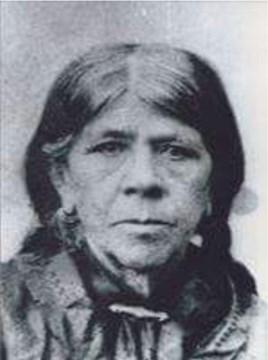Part of a series of articles titled Women's History in the Pacific West - California-Great Basin Collection.
Previous: Alice Piper
Next: Sarah Seaver Randall
Article

Courtesy of Arianne Chow-Garcia, Chairperson, Chalon Indian Nation.
Piu-uina came from the Chalon people, whose homeland encompasses what is now Pinnacles National Park. She lived most of her life within the Spanish mission system in California, but she also managed to pass down her Chalon identity to her descendants. Piu-uina exemplifies the ways Indigenous women navigated the mission system as they lived their lives.
Piu-uina was born in early 1793 in the Mission Nuestra Señora de la Soledad (or Soledad Mission) where she was given the Spanish name Josefa by the people who baptized her.1 Her parents, an Esselen woman named Leuváchajan or Guaásjats and a Chalon man named Piguina, were some of the first people to be baptized and married in the mission, probably due to the close proximity of her mother’s village to the newly created Soledad Mission.2 Whether Piu-uina’s family lived in or near the mission, their lives were deeply influenced by the religious rituals, labor requirements, and social regulation of the mission’s padres.3 However, Piu-uina probably grew up speaking her mother’s and father’s languages and learning the lifeways of her peoples. When Piu-uina was about eleven or twelve, she would have been sent to live in the sometimes-overcrowded women’s dormitories on the mission premises, where young single women and widows were locked in every night for their supposed protection.4
When she was thirteen, Piu-uina married a twenty-one-year-old Chalon widower named Baldomero.5 Marrying at a young age was not necessarily the norm among the Chalon or Esselen, but it was fairly common for Indigenous women in Spanish missions, possibly because of pressure from the mission padres or possibly because of high mortality rates among marriageable women from rampant disease.6 Baldomero worked as a translator for the mission leaders and served as a godparent in over two hundred baptisms. Piu-uina also served as a godparent in over sixty baptisms during her marriage to Baldomero, suggesting her status in her community and in the eyes of the padres.7
Between 1810 and 1811, Piu-uina’s husband died (probably due to disease), leaving her a widow at eighteen. She remarried a Spanish soldier, Martin Olivera, in October 1811.8 While priests and military leaders encouraged intermarriage between Spanish soldiers and Indigenous women early on in the establishment of the mission system, by the time of Piu-uina’s marriage to Olivera, intermarriage was much rarer. However, the connection gave her an elevated status in the eyes of the Spanish, and possibly more access to Spanish goods, money, and social networks.9 She had nine children over the next twenty years, mostly at the Soledad Mission, but also at the San Carlos Borromeo Mission in Carmel and the San Miguel Arcángel Mission in San Miguel, suggesting a mobility that came from being a soldier’s wife.10
As her husband rose in the military, Piu-uina began to gain a reputation as a midwife, probably assisting women with births both on and off the mission.11 Sometime in the 1830s, her family moved away from the Soledad Mission as the Franciscan mission system began to crumble and the Mexican government sold missions to private owners.12 In 1848, Piu-uina took her youngest child, fifteen-year-old Maria de los Reyes, and a grandson to one of these secularized missions (San Miguel) where she served as midwife for the pregnant Spanish-American wife of trading post operator William Reed. On December 5, a gang of mostly Anglo-American men, suspecting that Reed possessed a large amount of gold, attacked and killed everyone present at the post, including Piu-uina and her daughter and grandson. Eventually a local posse apprehended and executed the murderers.13
The notoriety of her brutal murder has ensured that Piu-uina’s Spanish name, Josefa Olivera, has survived in records. But her story of cultural and physical mobility, her connections to multiple Indigenous cultures, her skill as a midwife, and her life both as a child and adult in the missions paint a greater picture of who she really was. While many of the priests recording her children’s baptisms considered them Spanish, Piu-uina impressed upon her descendants a strong sense of their Indigenous cultural identity. Today many of the Chalon people in Bakersfield trace their ancestry back to her, preserving the memory of her story and suggesting a cultural persistence extending across centuries in the park region.14
Part of a series of articles titled Women's History in the Pacific West - California-Great Basin Collection.
Previous: Alice Piper
Next: Sarah Seaver Randall
Last updated: February 22, 2022